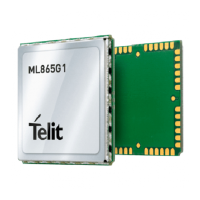If all the sub parameters of a parameter type command +CMD are optional, issuing
AT+CMD=<CR> causes the result code to be returned to OK and the previous values of the
omitted sub parameters to be retained.
2.2.1. String Type Parameters
A string, either enclosed between quotes or not, is a valid string type parameter input.
According to V25.ter space characters are ignored on the command line and may be used
freely for formatting purposes, unless they are embedded in numeric or quoted string
constants; therefore a string containing a space character must be enclosed between
quotes to be considered a valid string type parameter (e.g. typing AT+COPS=1,0,"A1" is
the same as typing AT+COPS=1,0,A1; typing AT+COPS=1,0,"A BB" is different from typing
AT+COPS=1,0,A BB).
A string is always case-sensitive.
A small set of commands always requires to write the input string parameters in quotes:
this is explicitly reported in the specific descriptions.
2.2.2. Command Lines
A command line is made up of three elements: the prefix, the body and the termination
character.
The command line prefix consists of the characters "AT" or "at", or, to repeat the
execution of the previous command line, the characters "A/" or "a/" or AT#/ or at#/.
The termination character may be selected by a user option (parameter S3), the default
being <CR>.
The basic structures of the command line are:
1. ATCMD1<CR> where AT is the command line prefix, CMD1 is the body of a basic
command (nb: the name of the command never begins with the character "+") and
<CR> is the command line terminator character
2. ATCMD2=10<CR> where 10 is a sub parameter
3. AT+CMD1;+CMD2=, ,10<CR> These are two examples of extended commands (nb:
the name of the command always begins with the character "+"2F2F). They are
delimited by semicolon. In the second command the sub parameter is omitted.

